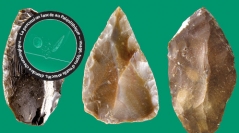

 Comptes Rendus Palevol
20 (37) - Pages 779-797
Comptes Rendus Palevol
20 (37) - Pages 779-797The Mousterian level of the Doline of Cantalouette 2, with a mean age of 60 000 years, is remarkable for its richness, composition and recurrent structuring of activities in space (Bourguignon et al. 2008). It also delivers a range of lithic tools used in percussion tasks. In addition to a large range of knapping hammers (on quartz pebbles, flakes or flint cores), massive flint flakes have also been used with percussion gestures for working perishable materials such as animal carcasses and plants. We will focus our present article exclusively on this last type of use. The lithic production activities of this Late Mousterian mainly involved an algorithmic knapping system, based on recurrent unidirectional series and obtained according to sub-parallel fracture planes following one or more surfaces. Thick flakes, often with lateral asymmetry, were obtained from one or more circumscribed percussion planes (opposite or perpendicular), which are very rarely prepared. More rarely, a preferential Levallois knapping system, oriented towards export of the products, was also implemented. At some distance from the knapping station the main production was made almost exclusively for immediate use with or without a preparation of the active and handling parts by retouching, (Bourguignon et al. 2008). From this lithic production, it was made a selection of massive flakes easily handled with bare hands. These blanks often came from the first stages of the operating chain (cortical) and were used in percussion tasks. On the basis of a macroscopic selection of the – often unretouched – cutting edges with stigmas of crushing, micro-flaking or scarring, a functional analysis was carried out according to the analytical methodology developed by Semenov (1964). As the tools were very large items, we produced replicas of the working edges on acetate for additional analysis with microscope. Two types of percussion activities were registered, one focused on butchering tasks and the other on woodworking. For the butchering activities, these large, massive flakes were used as cleavers, chopping knives or butchering blades. On the edges of these tools, large scars are documented, resulting from striking the bones during the disarticulation or chopping of animal parts. Hard/semi-hard vegetal and woody plant materials were also worked by percussion gestures, mainly in order to slim them. Some very large lithic tools suggest a two-handed grip. In those cases, only one of the edges is used. On the smaller items, which can be held with one hand, the number of active parts is greater (at least two). These active parts are often denticulate (presenting a number of notches, retouched or not). The use-wear polishes concentrate on these areas. In some cases, these denticulations were prepared previously to use. For other tools, denticulations may also be the consequence of the impact on the material during the percussion tasks. These two registered activities will, therefore, be presented here, detailing and illustrating the stigmas and use-wear polishes relating to each of them.
Launched persussion, massive raw materials: butchery tasks, wood working, Mousterian, France